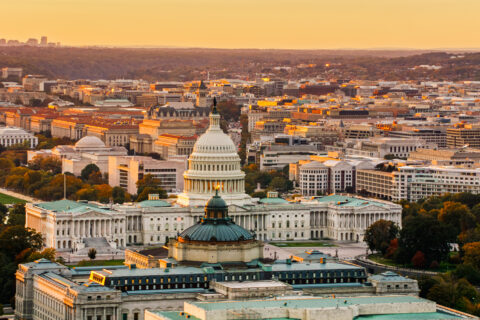After years of needing additional infrastructure aid, local leaders have unprecedented opportunities to invest in their communities because of the American Rescue Plan Act (ARPA), Bipartisan Infrastructure Law (BIL or the Infrastructure Investment and Jobs Act) and the Inflation Reduction Act (IRA). These federal investments have provided municipal leaders with new opportunities to make investments that can improve infrastructure conditions in cities, towns and villages across the US. Being thoughtful about how to include climate considerations into decision-making on current and future infrastructure can allow local governments to reduce direct losses from future repairs and the indirect costs from potential disruption.
NLC’s Local Authority and Federal Infrastructure Investments: A State-by-State Analysis report reviews four policies that can be directly impacted by these federal investments and be used as tools to support sustainable and equitable infrastructure development. These policies include electric vehicles (EV), State Infrastructure Banks (SIBs), Community Choice Aggregation (CCA) for municipal utilities, and Complete Streets policies—each of which could assist municipalities in addressing equity and climate change concerns by:
- Using renewable energy to meet local sustainability goals
- Increasing access to new technologies that support sustainable development
- Improving infrastructure conditions across the US, especially in predominantly Black, Indigenous and people of color (BIPOC) communities that are underserved
- Financing environmentally focused infrastructure projects that would not be possible without additional state or federal funding
Here’s how you can use these policy tools to invest in sustainable infrastructure for current and future residents:
EV Charging in Public Spaces
EV charging can reduce carbon emissions and improve local environmental conditions, especially when the power for chargers comes from renewable energy sources. Siting EV chargers can present both opportunities and challenges for municipal leaders. Local leaders may consider placing EV chargers in public places like parking garages, municipal lots, parks and other community spaces such as libraries, schools and recreation centers. Cities such as Cincinnati, OH, Ann Arbor, MI, and Auburn, WA, have created EV charging plans or ordinances for their municipalities. Cincinnati adopted an ordinance in 2017 that requires all publicly funded parking garages to provide EV chargers and designate at least one percent of spaces to EV charging. For local leaders interested in learning more about EV charging, check out NLC’s brief with a glossary of terms and blog on the National Electric Vehicle Infrastructure (NEVI) Formula program.
State Infrastructure Banks
Access to the low-cost financing that some SIBs offer to support climate and resilience is critical for local governments. The Rhode Island state legislature recently decided to transform its SIB to help achieve state sustainability and resilience goals, by expanding eligibility for clean energy and climate resilience projects. Nevada’s SIB has also adopted regulations to prioritize projects that promote environmental sustainability and create good-paying jobs in new infrastructure projects. Nevada’s bank also aims to fund at least 40 percent of projects in historically underserved communities.
Other states have established “green banks,” which take on a similar structure to SIBs, but are specifically designed to fund energy and climate projects. Connecticut formed the first statewide green bank in 2011 and funds the bank through a state ratepayer fund and private investment. Many states are now considering green banks to take advantage of newly available federal funding for clean energy projects through IRA’s Greenhouse Gas Reduction Fund, which is expected to fund existing green banks throughout the country. These new investments provide opportunities for local governments to access the financing they need to make investments in critical sustainable infrastructure that will serve them for years to come.
CCA for Municipal Utilities
CCA is a policy enabled by each state that can accelerate renewable energy use as well as help both states and municipalities pursue their sustainability goals. CCAs enable local governments to aggregate the energy demand in their municipality and purchase energy on behalf of customers in the municipality. Local governments can then purchase from renewable sources and negotiate lower rates by aggregating the energy demand in their municipality. In California, where the adoption of CCAs has been high, renewable energy purchases from CCAs have sped up the state’s progress toward clean energy goals, as CCA renewable energy purchases are twice in excess of the state’s renewable energy requirements. San Jose has utilized California’s CCA program to lower costs citywide and has launched additional programs to assist low- and moderate-income households with solar energy access and rebates on energy-efficient appliances. In states where CCA is allowed, local governments have a straightforward route to procure renewable energy and position their communities for a secure energy future, spur local jobs and renewable energy development, and reach to reach local and state-level sustainability goals.
Complete and Green Streets
Complete Streets offer local leaders a way to integrate road safety, economic growth, equity and sustainability into transportation projects and design. These changes enable roadways to be safe for all mobility users regardless of age, ability or mode of transportation. There are more than 1,600 Complete Street policies adopted across the country. Cleveland Heights, OH, adopted a Complete and Green Streets Policy in 2018. Like traditional Complete Street policies, the city’s ordinance focuses on safety and expansion of multimodal options to allow walkers, cyclists and public transit systems to share roads and sidewalks more with private vehicles. The “green” aspect comes from an effort to reduce the environmental impacts of transportation infrastructure and incorporating green infrastructure to reduce waste, stormwater runoff and energy consumption.
Looking Ahead
Investments in resilient and equitable infrastructure will support cities, towns and villages in the face of climate change impacts. To maximize federal and state funds, local leaders can take these steps to incorporate sustainability and equity into their investments:
- Identify needed infrastructure investments
When determining areas for improvement, municipalities must assess their current infrastructure conditions with a focus on equity to ensure they consider all community needs. Local leaders should communicate with an array of residents to request feedback and understand who current and future infrastructure conditions impact. For more information on infrastructure conditions across the US, review NLC’s 2022 Municipal Infrastructure Conditions report.
- Understand community vulnerability
Alongside the identification of gaps in current infrastructure conditions, municipalities can access tools and resources to overlay and understand vulnerability in their community. This data can inform project prioritization and the appropriate resilience strategies that a community can take to prepare for these impacts. It is essential that vulnerability is defined not only using municipal assessments and data but also by qualitative data and community conversations to ensure that project prioritization centers on what residents value.
- Review and apply for sources of federal funding
There are several opportunities for municipalities to take advantage of federal funding. Check out NLC on various funding opportunities, including NEVI, carbon reduction program, PROTECT, RAISE and IRA.
- Allow opportunities for local authority to address needed infrastructure improvements
Although local governments cannot solve every infrastructure concern alone, local authority or “home rule” over infrastructure allows cities, towns and villages to determine their needs based on their local contexts. As local governments apply for, receive and invest federal and state funds, local leaders can face varying regulatory requirements at the state level that may impact their responsiveness to funding. States should look for opportunities to allow for creative local solutions to address infrastructure issues and help residents.
Learn more
For more information on how to develop infrastructure in your community, check out NLC’s 2022 State Municipal League report, Local Authority and Federal Infrastructure Investments: A State-by-State Analysis. The report is an update to the 2016 report, which you can access here.









